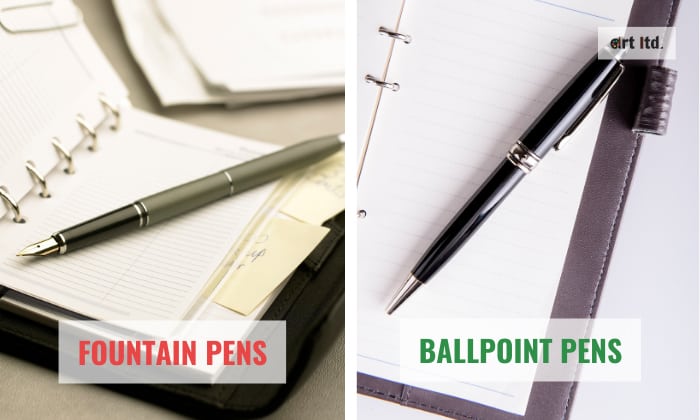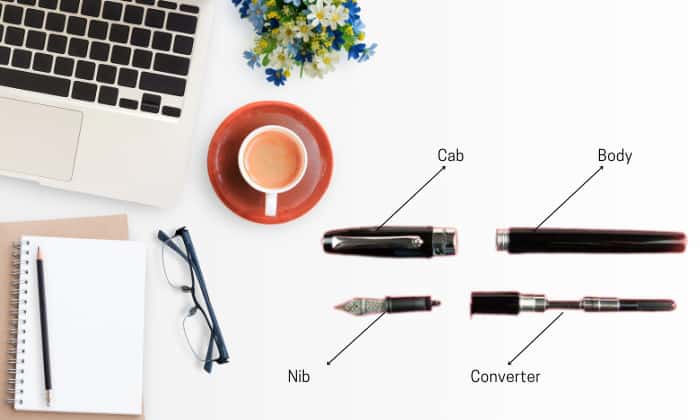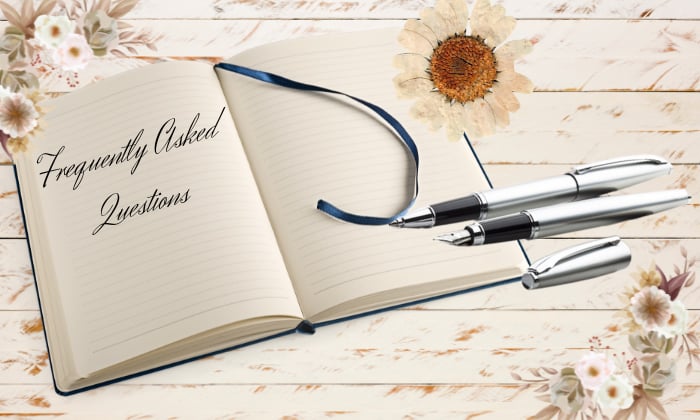If you don’t know whether to choose fountain pens vs ballpoint pens, you’re in the right place. In this article, we will discuss how they came about, how these pens work, their differences, how you can get to enjoy both and help you understand your pen preference.
| Feature | Fountain Pens | Ballpoint Pens |
| Ink Formulation | Water-based | Oil-based |
| Ink Consistency | Usually less viscous | Viscous |
| Packaging | Refillable, made with metals | Mostly made of disposable plastics |
Table of Contents
What Is a Fountain Pen?
A fountain pen is a writing instrument that uses water-based ink. It was invented to replace one of the oldest writing implements—the reed and the quill.
What defines fountain pen from its two predecessors is its metallic nib and a refillable ink reservoir, which eliminates the need for continual ink dipping.
There were several versions made for it to work, but the design was not perfected until 1884, when the first practical patent was devised by an American named Lewis Waterman.
It was made possible by adding groves and slits that gently stream air in the system, which would then regulate the ink flow.
This invention led to the charter of his company—Waterman Pen—which is one of the oldest fountain pens companies that have continued its legacy up until now.
Today, modern fountain pens are basically composed of a metal nib where ink is released, a barrel that holds the ink cartridge and the converter, and a cap that prevents ink from leaking and drying out.
How Do Fountain Pens Work?
A fountain pen utilizes the force of gravity to pull the ink from the reservoir to the nib. Once the ink reaches the nib, capillary action takes place. This is when the adhesive force across the surface of the nib and the ink directs and controls the ink flow down to the tip.
One advantage of fountain pens is their incredibly diverse and customizable ink. As such, you can expect to find ink with any shade and viscosity.
Regarding the component for holding ink, there are 4 fountain pen types:
- Cartridge: insert-type disposable ink cartridge.
- Eyedropper: uses eyedropper for refilling ink
- Converter: has a syringe-like ink bottle.
- Crescent: features an irremovable ink rubber bladder
As for tip types, there are more than a dozen options, depending on where you intend your fountain pens used for. But, generally, it can be narrowed down into three categories.
1. Broad tips
- Flat edge and rigid metal
- Good for italic writing
2. Conventional tips
- Rounded and slightly flexible
- Good for everyday writing
- Available in 0.5-1.9 mm size
3. Pointed tips
- Sharp and extra flexible
- Good for technical drawing
Read more: Fountain pen vs calligraphy pen – Which one to opt?
What’s a Ballpoint Pen?
The ballpoint pen is a more popular writing tool—commonly used for its versatility, accessibility, and, most of all, affordability.
Thanks to the efforts of the Biro brothers, an editor and a chemist from Hungary, the first viable ballpoint pen came about in the 20th century. The commercialized design was later called “Birome”, following the patent obtained by László József Bíró in 1943.
Its formulation was adopted from newspaper ink and tweaked into a thinner consistency to pass through the ball and socket without clogging them. Meanwhile, the metal ball was significantly reduced in size for better ink flow.
7 years later, the patent was sold to BIC, the company that pioneered the mass production of the cheapest pen, which eventually dethroned the fountain pens. To date, the same principle used in Birome pens still lives on.
The image below shows what a ballpoint pen looks like. This modern model primarily comprises the refill cartridge that holds the ink and the tip, the barrel that guards the cartridge, a small spring, the thrust device, which has retraction controls with every click, and the top cap.
How Does a Ballpoint Pen Work?
A ballpoint pen uses the ball and socket mechanism and gravity to pull ink from the ink tube.
The small metal ball on the pen’s tip is fitted on a socket large enough for it to roll freely. One side is exposed to the ink and the other side is exposed to the open. As the ball rolls, it gets the ink from the ink side and delivers the ink to the surface you wish to write.
A ballpoint pen can either be disposable or refillable, although the latter type is not as common.
- Disposable pens: typically made with cheap plastics
- Refillable pens: feature sturdier barrels with replaceable ink tubes.
What Are Differences?
1. Ink type
Fountain pens use a more fluid water-based ink. As it flows smoother, you need less effort to write. However, this ink takes time to dry and is prone to smudging or fading. Moreover, fountain pens can only write on paper.
Ballpoint pens, on the other hand, use thicker oil-based ink that requires slightly more effort to write. However, their ink is permanent, compatible with most surfaces, less likely to smear, and can dry instantly.
2. Design
Another difference is that the fountain pens are highly customizable. Not to mention, they have replaceable tips and different ink refill options, depending on the design.
Meanwhile, the ballpoint pen doesn’t have replaceable tips and is limited to ink tube refills. That said, these ink tubes can write longer and can be pressurized, so they can work at higher altitudes and underwater.
3. Cost
Ballpoint pens are generally cheap and can cost less than a dollar apiece. Meanwhile, fountain pens are pretty expensive—even the cheapest one you can find would be around $5, although the average price range is $100-$300.
4. Maintenance
Fountain pens require great care and maintenance, although the exact degree varies depending on the specific type, with most requiring disassembly and section cleaning. Routine maintenance should be done at least once a month to keep the pens in tip-top shape.
Ballpoint pens, on the other hand, do not need maintenance. In the rare occasion that they’re clogged, applying heat around the tip should fix the issue.
Pros and Cons
1. Fountain Pens
- Multiple tip types
- Replaceable tips, highly customizable
- Less waste
- Less effort is required to write
- Ink takes longer to dry
- Need more maintenance
- Can get messy due to smudging
- Can fade over time
- Works on paper only
- Usually more expensive
2. Ballpoint Pens
- Dries quickly
- Convenient and easy to use
- Low cost
- No maintenance
- Works on various surfaces
- Ink last longer
- Need more pressure to write
- Non-replaceable parts
- Need more pressure to write
Ballpoint vs Fountain Pen: Which is Better?
Well, that primarily depends on your application, budget, and personal preference. There’s no question; ballpoint pens are nifty, cheap, and easy to use. So, they’re most suitable for convenience and practicality.
So, why use a fountain pen?
For starters, ballpoint pens cannot provide the comfort, personalization, and elegance a fountain pen can offer. Not to mention that these pens are better if you care more about your writing style or if you want to experience a luxury experience through them.
Frequently Asked Questions
Are fountain pens actually better?
This depends on what specific needs you have. In terms of writing experience, fountain pens are better than their ballpoint counterparts. And as you can refill and continue to use them, they’re also better for the environment.
In contrast, ballpoint pens are usually disposable, so they can produce more carbon footprints. However, their compatibility with various surfaces and lightfast ink can make them an ideal option.
Do fountain pens last longer than ballpoint pens?
In terms of ink, ballpoint pens can last longer as they use less ink. It can write up to 300 pages, while a fountain pen can only run for not more than 15 pages.
That said, fountain pens are refillable. So, in theory, you can use a fountain pen indefinitely as long as it doesn’t break.
Conclusion
Bottom line, if you are to choose between fountain pens vs ballpoint pens, there are a few factors that affect choosing the right pen for you; these include:
- Paper material or surface:
- Style of writing
- Application or the kind of writing activity
- Budget
- Level of maintenance
We hope that this article has helped you figure out which pen is more suitable for you.

Art has always been a part of my life; it influences my upbringing and later my career choice. For me, it is always a part of my parenting technique. So for whichever purpose that you come to art, you can start here with us.










